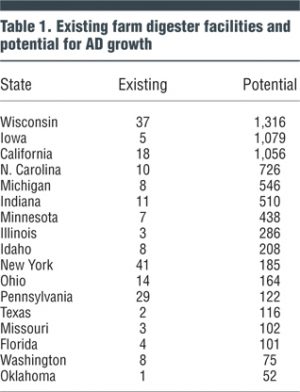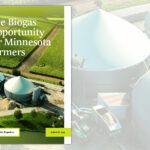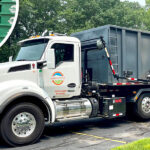Using electricity produced with biogas as a fuel for electric vehicles was finalized by EPA under the Renewable Fuel Standard in 2014. To date, no pending applications have been approved.
Michael Lemon and Jim Lemon
BioCycle June 2017
Recently, a federal Interagency Task Force on Agriculture and Rural Prosperity, chaired by U.S. Secretary of Agriculture Sonny Perdue, was created “to promote economic development and revitalization, job growth, infrastructure, innovation and quality of life issues for rural America.” One long-standing U.S. EPA program that is already helping rural farming communities across America achieve these goals is the Renewable Fuel Standard (RFS). But certain sectors of the agricultural community cannot currently participate in the RFS. Action by President Trump’s administration could change that.
Congress created the RFS to diversify the nation’s energy portfolio, reduce dependence on foreign oil, and strengthen the economy of rural communities through production of domestic biofuels. To meet these goals, the RFS requires that gasoline and diesel refiners and importers (“obligated parties”) blend renewable fuels, like ethanol, with the liquid fuels used for transportation. With over 500,000 electric vehicles sold in the U.S., electricity produced with biogas from manure and other organic materials at dairy, swine and other farms also qualifies as a renewable fuel under the RFS.
Electric Pathway
Since its inception in 2005, the primary fuel in the RFS program has been ethanol produced with corn. But in 2014, the EPA finalized a regulatory process that approved electricity produced with biogas as a RFS fuel for use in electric vehicles (often called “the electric pathway”). Under this pathway, farms would sell E-RINs, which represent corresponding amounts of electricity produced with biogas and consumed on the same electric grid. Accordingly, for the first time it appeared that numerous dairy, poultry and swine farmers would also participate in the federal RFS program, just as corn farmers have for many years. However, because EPA has still not approved any pending applications for the electric pathway, these farms remain unable to participate.
Approving pending applications to bring electricity from these farms into the RFS would emphasize the Trump Administration’s progrowth, proenvironment approach to the EPA’s core mission of improving air and water quality by using the tools in its toolbox — the electric pathway does not require a new rulemaking and falls under a long-standing statutory program. The program would help farmers across America manage animal and food wastes via anaerobic digestion (AD) to produce electricity with biogas and participate in the RFS program. Additionally, programs like this would provide a crucial additional revenue stream to the farms, and help strengthen and grow the economies of rural farming communities.
According to U.S. EPA AgSTAR data, approximately 275 farm digesters are operating in the U.S., primarily at dairy and swine farms located in the states in Table 1. Almost all use the biogas produced to power an electricity generator and then sell base load electricity to a local commercial power grid.
Sale of electricity is often the primary revenue source for AD facilities. So, when electricity prices collapse — like they have in states like Wisconsin and New York, where power purchase agreements between utilities and farms are being renegotiated — farms struggle to keep their digesters operating. Many dairies in Wisconsin, for example, have reportedly seen their electricity revenues drop from 7 cents to 3 cents per kilowatt hour, a rate that barely covers the cost of operating the digester. Participation in the electric pathway can increase the value of the electricity produced and help maintain a farm’s ability to profitably manage manure and organic waste, and realize the on and off-farm benefits associated with farm AD: reducing on-farm energy bills, limiting water pollution from agricultural runoff, improving soil health, and reducing odors.
Vast quantities of organic resources are available to feed digesters in the U.S.; primary feedstock sources include livestock manure, food waste, and food production residuals. And the potential for digester growth in agricultural areas is huge. According to the Biogas Opportunities Roadmap released in 2014, over 8,000 existing farms could support digesters, and each digester represents between $2.5 and $10 million in new investment and could support two to four new permanent jobs. States with the greatest potential for digester growth are also shown in Table 1.
Activating E-RIN Pathway
By robustly activating the electric pathway, the EPA can help USDA Secretary Perdue and the Interagency Task Force on Agriculture and Rural Prosperity directly promote rural economic development and revitalization. BTR Energy, based in Washington, D.C., estimates the electric pathway could generate an additional 4 to 7 cents for each kilowatt hour of electricity produced with biogas at farms participating in the program. That additional revenue would motivate investment and support new jobs in rural America.
In his confirmation hearing, Perdue said he wanted “to remove every obstacle” limiting farmers’ opportunities to prosper. Inability to participate in the electric pathway is such an obstacle that can be easily removed, just like most things in Washington, with the stroke of an EPA pen to approve pending electric pathway applications.
Michael Lemon is a cofounder of BTR Energy, a public benefit company, based in Washington, D.C. and created to increase production of domestic renewable electricity from waste. Before BTR, he started a nonprofit to accelerate the adoption of AD technology in the U.S. Jim Lemon is a cofounder of BTR Energy. He grew up working on farms and feedlots in Texas, Oklahoma, Kansas and New Mexico. Contact them at hello@btr.energy.













